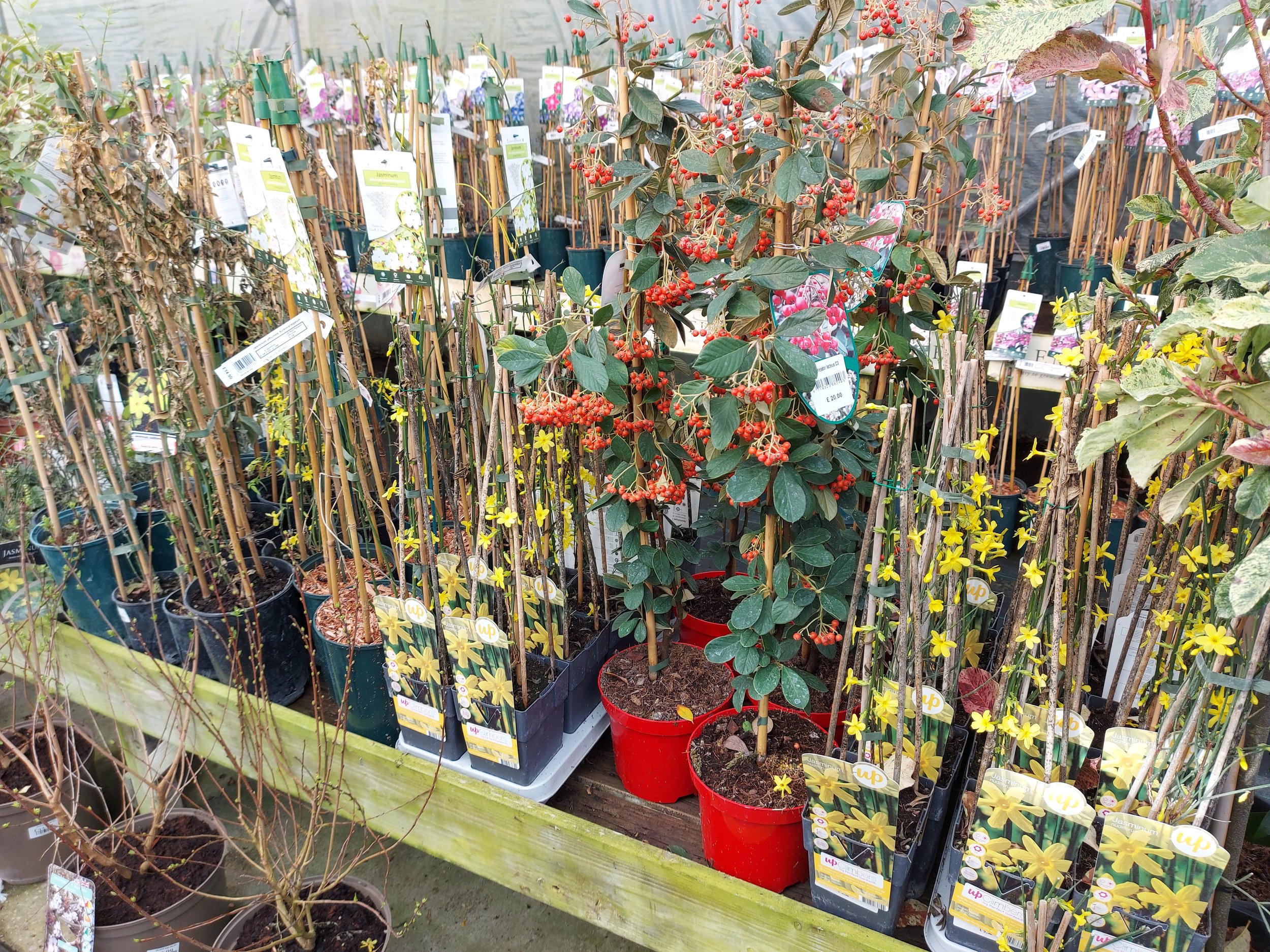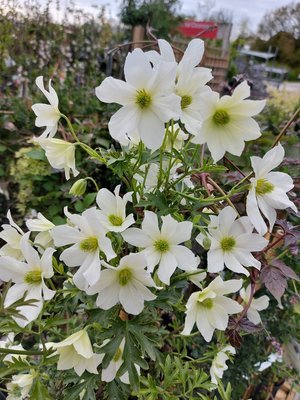Climbing Plants and Wall Shrubs
Climbing plants have a place in every garden; for covering walls of buildings, to clamber up pergolas, spread across low walls, fences and smother eyesores such as dead tree stumps. Climbers and ramblers will add colour to trees and shrubs by growing through them, or as ground cover for difficult banks and borders.
Two climbing plants will happily grow through each other to compliment each others flowering period, or one to provide evergreen foliage for the winter. On sunny sheltered walls, plants requiring some protection may be successfully grown. Self clinging plants will adhere to a wall once established and will do no damage to sound brickwork. Most of these plants are best pruned as follows unless otherwise stated: - After flowering or in late winter/early spring, cut back flowered shoots to within 2-4 buds of permanent framework. Any dead, misplaced, old or unwanted shoots should be removed at the same time.
-

ABUTILON
All varieties need a sheltered sunny wall in well drained soil. Graceful lax habit. Flowers over a long season. Deciduous to semi-evergreen. Only frost hardy varieties are listed here, but all will need protection from hard frosts and wind.
-

ACTINIDIA KOLOMIKTA
Fragrant white flowers June. Slender climber with leaves flushed cream and pink on lower half. Leaves attain full colour once the plant is 3-4 years old. Height 4.5-5m.
-

PASSIFLORA
Passion Flower. Usually deciduous in the UK. All need a sunny sheltered site and well drained soil. Ideally a south or west facing wall. Prune in early spring. This is not the edible passion fruit. Only frost hardy varieties are listed here.
-

TRACHELOSPERMUM
Star Jasmine - Evergreen twining climbers, suitable for a sheltered sunny position and well drained soil. All have sweetly scented jasmine-like flowers in summer. Prune in early spring. All may need protection from severe frosts and wind.
-

SOLANUM
Twining semi-evergreen climbers, all need sheltered gardens and a south or west aspect. Prune after flowering. Do not hard prune.
-

WISTERIA
Will thrive in a sunny site on good well drained soil. Vigorous twining habit. Ideal for walls, sheds, pergolas and to grow through established trees. Fragrant flowers in late spring/early summer. Pruning - Left un-pruned plants develop into a thick tangle of intertwining stems which may not flower. Prune current year's lateral growths back to about 15cm end of July - early August. Prune again back to 3 buds in February.
-

LONICERA - HONEYSUCKLE
Honeysuckle - Popular flowering plant which thrives on a good moist but well drained soil in sun and partial shade. Fast growing climber requiring support.
-

HYDRANGEA
These are climbing forms of the popular shrub, they cling by aerial roots and do not need wires or trellis. All require shady sheltered site and moist, well drained soil.
ANOMELA PETIOLARIS - (Climbing Hydrangea) – Deciduous self-clinging shrub. Masses of white "lace cap" flowers 15cm across June - July. Height 10-15m. Vigorous once established. Prune after flowering.
-

CLIMBING FUCHSIA
Vigorous and hardy climbing Fuchsias that each produce an abundance of flowers along upright climbing stems throughout the summer to October. With a little support they will rapidly climb up arches, fences and trellis and are ideal for large pots or containers on the patio.
-

MANDEVILLA
Also known as Dipladenia, Brazilian jasmine and rock trumpet, is a woody climber native to tropical Central and South America. It has gently scented, vibrant blooms and makes a fine conservatory plant in the UK. Can be enjoyed outside over summer but not hardy in this climate over winter.
-

PILEOSTEGIA VIBURNOIDES
A stunning evergreen climber. A variety a ‘Climbing Hydrangea’. It has dark green, glossy foliage and clusters of star shaped, fragrant white flowers that bloom in late Summer and early Autumn. It’s vigorous growth rate makes it perfect for climbing walls, trellises, and fences. It is also an excellent ground cover. Can thrive in partial shade to full sun.
-

THUNBERGIA
Black-eyed Susan enjoys warm, slightly humid weather with shelter from cold winds. Can be grown outside outdoors in the summer and treated as a summer ‘bedding’ plant, fantastic in hanging baskets and as a climber in pots and borders.
-

BOUGAINVILLEA
A showy and colourful evergreen for the home, conservatory, or greenhouse. The showy ‘flowers’ come in a huge colour range but most commonly purple. Frost-free growing conditions are essential, so here in the UK it can only be grown outdoors in summer. Bougainvilleas can produce repeated flushes of bloom for many months if conditions are right.
-

CLEMATIS CIRRHOSA
Scented, bell-like, cream winter flowers against glossy, dark green foliage makes this evergreen clematis ideal for training over a sunny pergola or arch to enjoy its winter flowers.
-

CLEMATIS X CARTMANII 'JOE'
'Joe' is a slow growing trailing or scrambling evergreen climber with divided, leathery, dark green leaves and clusters of bowl-shaped, white flowers in early spring.
-

CLIMBING ROSES
An excellent way of bringing height, scent and a colour to your garden. Frequently used on walls but are also perfect for growing on pillars, obelisks, walls, trellises and over arches. Nearly all varieties have repeat flower. There are numerous types of climbing roses. From small to large ramblers.
-

PANDOREA JASMINOIDES
A vigorous, tender, twining climber with wiry, branching stems. It produces fragrant, tubular pink flowers from spring to summer. Not fully hardy in the UK.
-

JASMINIUM
Jasminum are evergreen or deciduous shrubs, shrub varieties are available but most are climbers, using twining stems bearing star-shaped white, pink or yellow flowers, which can be very fragrant.
-

SHRUB CLEMATIS
A compact and bushy, self-supporting form of the well known climber. Produces fragrant, hyacinth-shaped blooms in a cool shade of blue pink and white from July through to autumn. Growing to around 90cm tall without the need for an obelisk or trellis—it can just sit in a border and look stunning.
-

CLEMATIS ARMANDII
These spring flowering evergreen clematis produce clusters of sweetly scented flowers. Armandii prefer a sunny, free draining location to enable them to perform at their best. Prune immediately after flowering.
-

EVIPO CLEMATIS
This new range of clematis are summer flowering, large flowering and repeat flowering but also designed for pots and small obelisks! Usually growing to around 120cm.
-

CLEMATIS INTEGRIFOLIA
Perfect for scrambling through shrubs, over banks and tumbling down walls. It's also great trained through trellis and garden obelisks too. The gently scented, nodding flowers are unusual and followed by decorative seed heads for a long lasting display.
-

CLEMATIS ROYALTY COLLECTION
A collection of hardy clematis that produce distinctive shaped blooms sure to add a charming colour to your garden. Blooming from June through to September where they can reach a height 2m unless pruned. The collection includes; Princess Diana, Prince William and Princess Kate and Queen Mum.
-

VITIS - GRAPE
Ornamental grape vines, all are vigorous and cling to supports themselves with twining tendrils. They need good soil and will thrive in sun or part shade. Prune in midwinter and again in midsummer, if necessary, to restrict growth. Never prune in late winter or spring when the sap is rising.
-

CLEMATIS CIRRHOSA 'FRECKLES'
Cirrhosa var. purpurascens 'Freckles'. This vigorous winter flowering climber has pale cream nodding flowers which are heavily freckled inside. Freckles blooms in great abundance from Autumn to spring and is one of our best selling evergreen clematis.
Awarded the RHS Award of Garden Merit
-

CLEMATIS MULTI-BLUE
Clematis 'Multi Blue' has stunning navy blue, double then later semi-double flowers all throughout summer. It's a compact clematis, making it ideal for growing at the front of a border, in smaller gardens, pots and containers.
-

PARTHENOCISSUS 'VIRGINIA CREEPER'
Fantastically popular due to its unrivalled autumn colour. Its five-pointed, deeply divided, green leaves turn brilliant shades of crimson red in autumn with occasional dark purple berries. It's a showstopping plant that needs lots of space or regular pruning.

Summer Climbers

















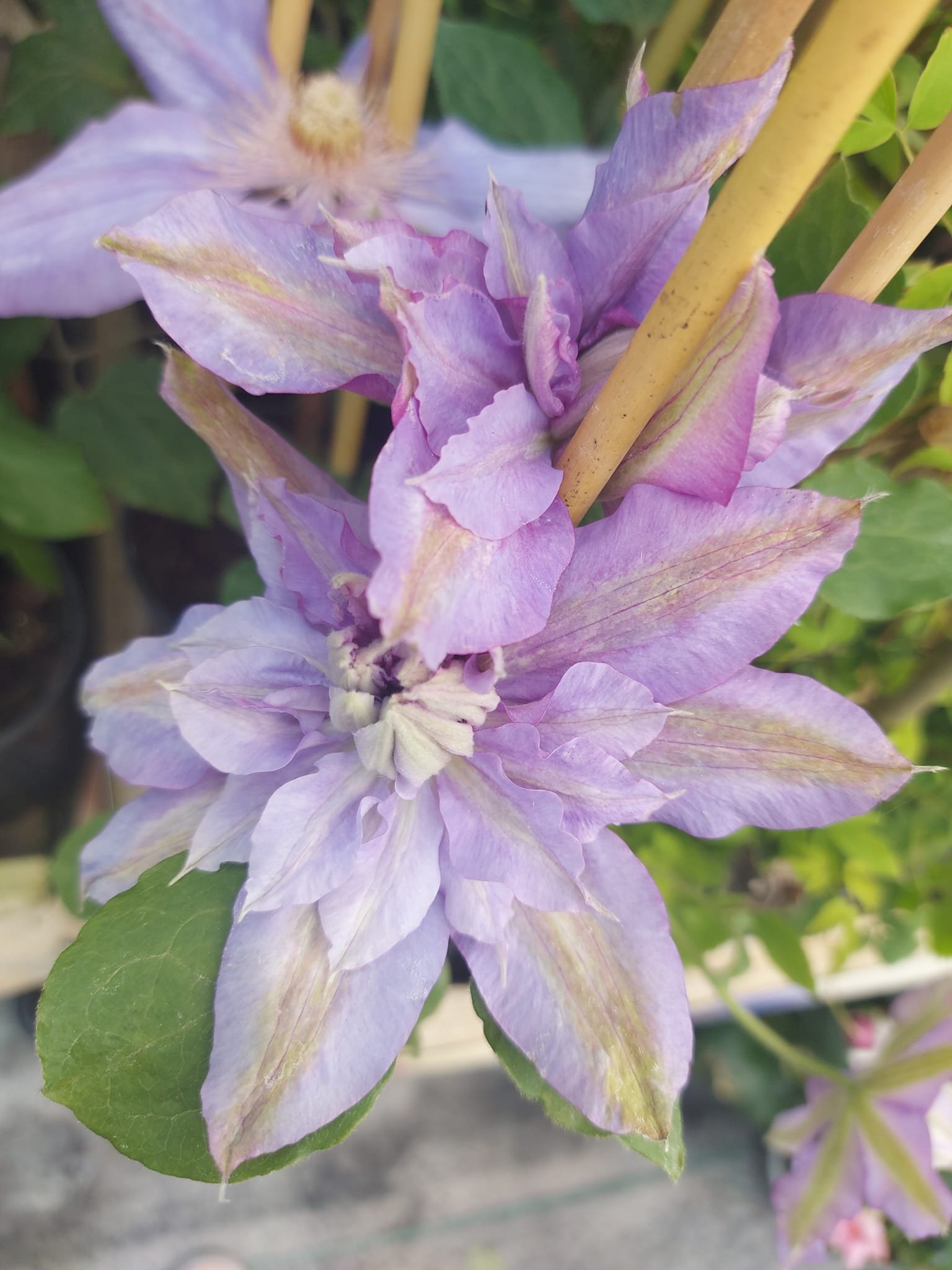






















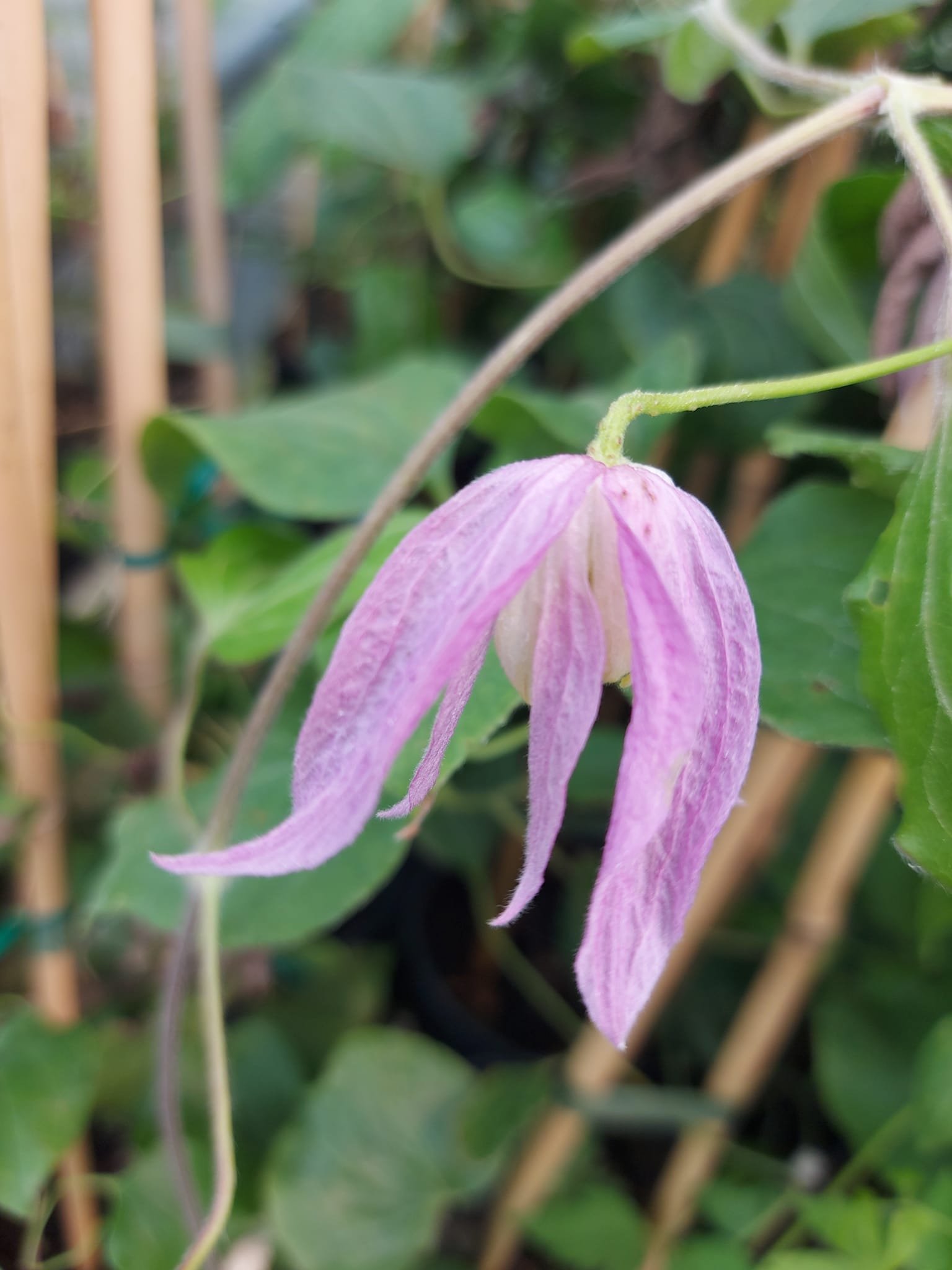





































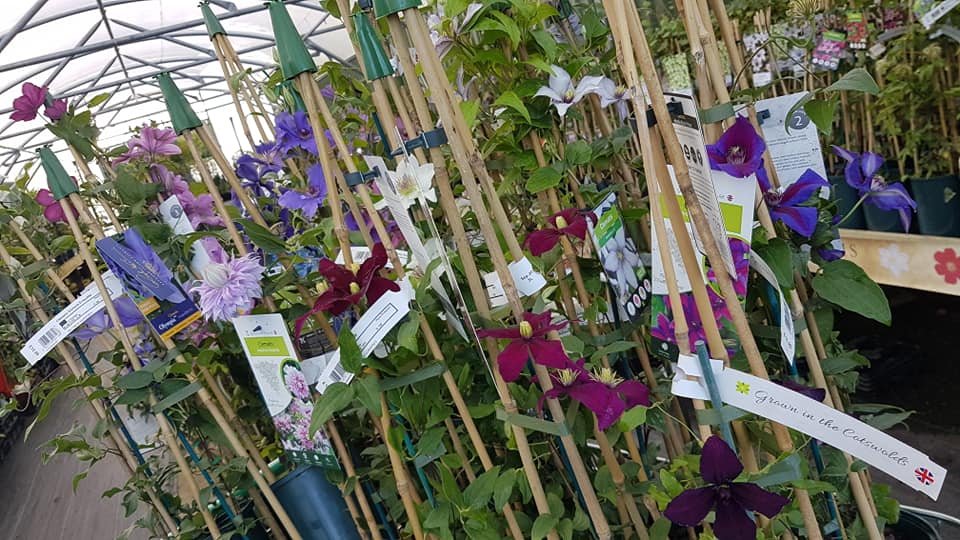






Winter and Spring Clematis




